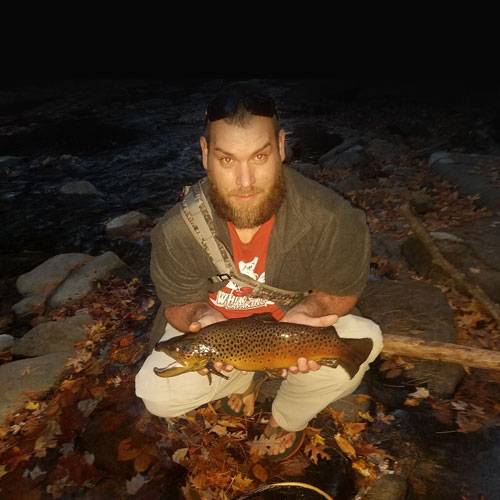There is nothing better than the sound of a rushing stream. As you stand in the water, listening to the sounds of Mother Nature’s symphony, calming your mind and body, while hearing no man-made noise. At this point, you could even forget your everyday life exists…This is the effect fishing for wild trout has on me.
Wild trout streams are often referred to as “blue lines”. This is a reference to them appearing on a map as a blue line. In Western North Carolina, when fishing for wild trout, you will come across two different regulations: Wild Trout Waters and Wild Trout/Natural Bait Waters. Wild Trout Waters season is open year-round, and you may only use artificial lures having one single hook. You may only keep four fish, and the four fish must be at least seven inches long. Also, it is unlawful to possess natural bait on your person while fishing in these waters. Wild Trout/Natural Bait Waters Season is open year-round. You may use a single hook artificial lure, or you may use a single hook with natural bait, except live fish. You may only keep four fish and the four fish must be at least seven inches long. According to NC Wildlife, an artificial lure is defined as “a fishing lure that neither contains, nor has been treated with, any substance that attracts fish by the sense of taste or smell” and natural bait is defined “as any living or dead organism (plant or animal), or parts thereof, or prepared substances designed to attract fish by the sense of taste or smell”.
A lot of people are intimidated by wild trout, or think you have to hike miles and miles to catch one. I think the longest I have hiked into one of my favorite streams is 20 minutes. Most places I have discovered are almost beside a road. They haven’t been written about in any book or magazine, and I only found them by searching new areas of Forest Service. www.ncwildlife.org has a great interactive map, that shows all of the trout streams in NC, and they are color coded according to designation. I have used this resource, many times, for my personal research.
Wild trout can be very spooky at times. This fact has almost become folklore among anglers. The belief has even crossed over to any trout, in any water. Don’t get me wrong, trout can be super spooky in low water, or heavily fished areas. Trout see better, when sitting on the bottom of a deep hole. In low water, they do not have this luxury. Limited vision makes them scared of anything out of the ordinary, including shadows, splashing, and underwater vibrations. During these times, stealth is your friend. Keep a low profile and limit your false casts, so you don’t scare fish with your shadow.
During busier times on stocked waters, consider fishing for wild trout. There are many streams in WNC that don’t see much angling pressure. This will give you an advantage, because the trout don’t see many flies. I have found that many attractor patterns, presented the right way, can have better results than trying to match the hatch.
Wild trout are usually only found in beautiful areas with clean, clear water, and very few people. Blue lines might not produce a lot of big fish, but they can provide many great memories.
Justin Mickens is Co-Owner and Manager of Appalachian Outfitters Fly Shop in Murphy, NC
